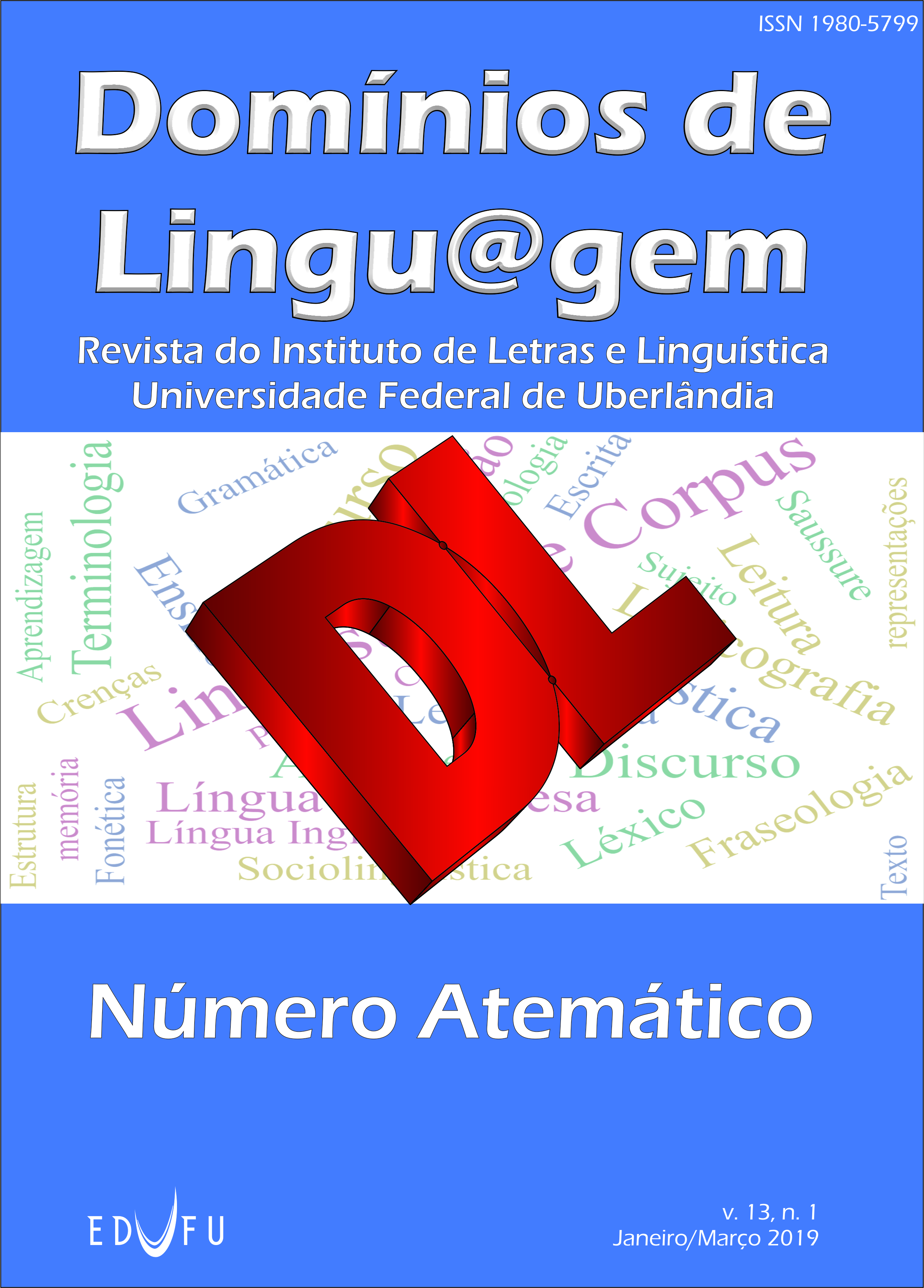A interação entre o tratamento instrucional e a prontidão de desenvolvimento de aprendizes no processo de aquisição dos clíticos de terceiras pessoas do espanhol
DOI:
https://doi.org/10.14393/DL37-v13n1a2019-9Palabras clave:
clíticos de terceiras pessoas, instrução com foco na forma, Espanhol.Resumen
Neste estudo analisamos e discutimos a interação entre a prontidão de desenvolvimento de estudantes com mais e menos tempo de estudo e a intervenção instrucional destinada ao ensino dos clíticos de terceiras pessoas do Espanhol por universitários brasileiros. Os dados foram submetidos ao software International Business Machine Statistical Package for Social Studies (SPSS). Fizeram parte deste estudo 10 participantes de uma universidade pública. Os resultados, de modo geral, sugeriram evidências contrárias à Hipótese da Ensinabilidade.
Descargas
Referencias
BARDOVI-HARLIG, K.; COMAJOAN, L. Order of Acquisition and Developmental Readiness. In: SPOLSKY, B.; HULT, F. (org.). The Handbook of Educational Linguistics. Australia: M. Blackwell Publishing, 2008. DOI https://doi.org/10.1002/9780470694138.ch27
CRUZ, M. L. O. B. Estágios de interlíngua: estudo longitudinal centrado na oralidade de sujeitos brasileiros aprendizes de espanhol. 2001. 316 f. Tese (Doutorado em Estudos da Linguagem) – Universidade Estadual de Campinas (UNICAMP), Campinas, 2001.
DOUGHTHY, C; WILLIAMS, J. Focus on form: theory, research, and practice. (ed). Focus on form in classroom second language acquisition. Cambridge: CUP, 1998.
DOUGHTY, C. Second language instruction does make a difference: Evidence from an empirical study of ESL relativization. Studies in Second Language Acquisition, 13 (2), 431-469.
ELLIS, R. Introduction: Investigating form-focused instruction. Language Learning, S1: Supplement 1, p. 1-46, 2001. DOI https://doi.org/10.1111/j.1467-1770.2001.tb00013.x
ELLIS, R.; LOEWEN, S.; ELDER, C.; ERLAM, R.; PHILP, J.; HAYO, R. Implicit and Explicit Knowledge in Second Language Learning, Testing and Teaching. Bristol: Short Run Press, 2009.
GONZÁLEZ, N. T. M. Cadê o pronome? O gato comeu. 1994. 451 f. Tese (Doutorado em Letras), Universidade de São Paulo (USP), São Paulo, 1994.
KONSTANTOPOULOS, S.; HEDGES, L. Meta-Analysis. In: KAPLAN, D. (ed.). Handbook of Quantitative Methodology for the Social Sciences. New York: Sage, p. 281-297, 2004.
KLEE, C. A. The acquisition of clitic pronouns in the Spanish interlanguage of Quechua speakers: A contrastive case study. Hispania, v. 72, p. 402-408, 1989. DOI https://doi.org/10.2307/343164
LYSTER, R.; RANTA, L. Corrective feedback and learner uptake negotiation of form in communicative classroom. Studies in second Language Acquisition (SSLA), v.9, p. 37-66, 1997.
MEISEL, J.; CLAHSEN, H.; PIENEMANN, M. On determining developmental stages in natural second language acquisition. Studies in Second Language Acquisition, v. 3 (2) 109-35, 1981. DOI https://doi.org/10.1017/S0272263100004137
NORRIS, J.; ORTEGA, L. Effectiveness of L2 instruction: A research synthesis and quantitative meta-analysis. Language Learning, 50, 417-528, 2000. DOI https://doi.org/10.1111/0023-8333.00136
PIENEMANN, M. Psychological constraints on the teachability of languages. Studies in Second Language Acquisition, 6 (2), 186-214, 2008. DOI https://doi.org/10.1017/S0272263100005015
PIENEMANN, M. Learnability and syllabus construction. In: HYLTENSTAM, K.; PIENEMANN, M. (ed.). Modeling and assessing second language acquisition. Clevedon, Avon: Mutilingual Matters, 1985. p. 23-75.
PIENEMANN, M. Is language teachable? Applied Linguistics, 10 (1) 52-79, 1989. DOI https://doi.org/10.1093/applin/10.1.52
PIENEMANN, M. Determining the influence of instruction on L2 speech processing. Australian Review of Applied Linguistics, 10 (2), 83-113, 1983. DOI https://doi.org/10.1075/aral.10.2.07pie
PIENEMANN, M.; JOHNSTON, M.; BRINDLEY, G. Constructing an acquisition-based procedure for second language assessment. Studies in Second Language Acquisition, v. 10, n. 2, p. 217-243, 1998. DOI https://doi.org/10.1017/S0272263100007324
SHINTANI, N.; LI, S.; ELLIS, R. Comprehension-Based Versus Production-Based Grammar Instruction: A Meta-Analysis of Comparative Studies. Language Learning, v. 63, n. 2, 2013 p. 296-329. DOI https://doi.org/10.1111/lang.12001
SWAIN, M. Three functions of output in second language learning. In: COOK, G.; SEIDLHOFER, B. (Orgs.). Principles and practice in applied linguistics: Studies in honour of H. G. Widdowson. Oxford, UK: Oxford University Press, 1995, p. 125-144.
SWAIN, M. Atención a la forma a través de la reflexión consciente. In: DOUGHTY, C.; WILLIAMS, J. (org.). Atención a la forma en la adquisición de segundas lenguas en el aula. Traducción y edición española Editorial Edinumen, 1998.
SWAIN, M. The output hypothesis: Theory and research. In: HINKEL, E. (org.). Handbook on research in second language teaching and learning. New Jersey: Lawrence Erlbaum Associates, 2005, p. 471-483.
SWAIN, M.; LAPKIN, S. Problems in output and cognitive processes they generate: a step toward second language learning. Applied Linguistics, v. 16, p. 371-391, 1994. DOI https://doi.org/10.1093/applin/16.3.371
SPADA, N. Form-focused instruction and second language acquisition: A review of classroom and laboratory research. Language Teaching. 30, 73-87. 1997. DOI https://doi.org/10.1017/S0261444800012799
SPADA, N. Beyond form-focused instruction: Reflections on past, present and future research. Language Teaching, 44, 225-236, 2010. DOI https://doi.org/10.1017/S0261444810000224
SPADA, N. Form-focused instruction: isolated or integrated? TESOL Quartely, 42 (2), 181-207. 2008. DOI https://doi.org/10.1002/j.1545-7249.2008.tb00115.x
SPADA, N.; TOMITA, Y. Interactions between type of instruction and type of language feature: A meta-analysis. Language Learning, 60(2), p. 1-46, 2010. DOI https://doi.org/10.1111/j.1467-9922.2010.00562.x
VILLALBA, T. K. B. A transferência na aquisição da anáfora pronominal em espanhol por universitários brasileiros. 1995. 90 p. Dissertação (Mestrado em Letras), Universidade Federal do Rio Grande do Sul (UFRGS), Porto Alegre, 1995.
Descargas
Publicado
Número
Sección
Licencia
Domínios de Lingu@gem utiliza la licencia Creative Commons (CC) CC BY-NC-ND 4.0, preservando así la integridad de los artículos en un ambiente de acceso abierto. La revista permite al autor conservar los derechos de publicación sin restricciones.









